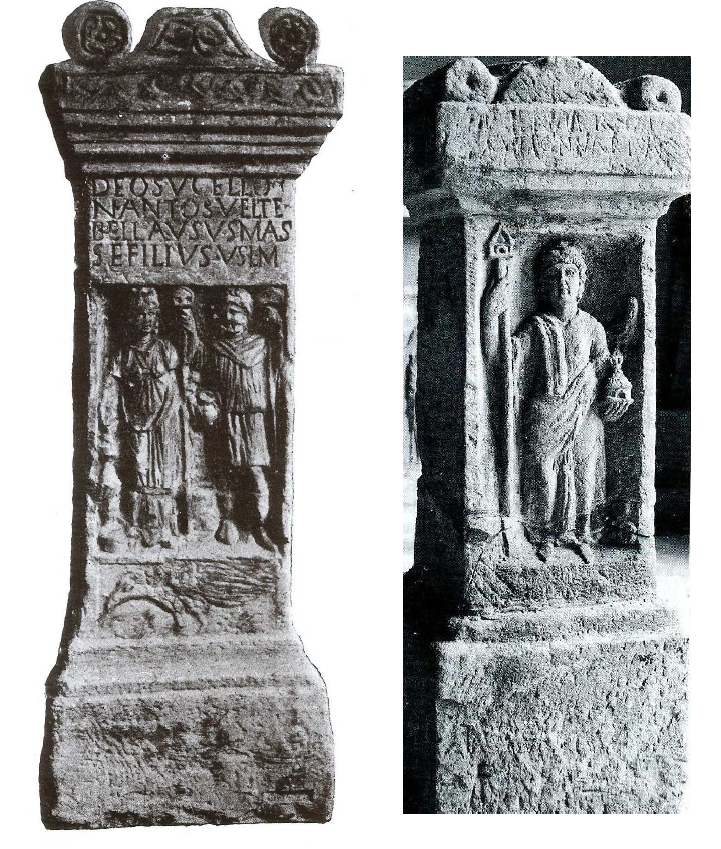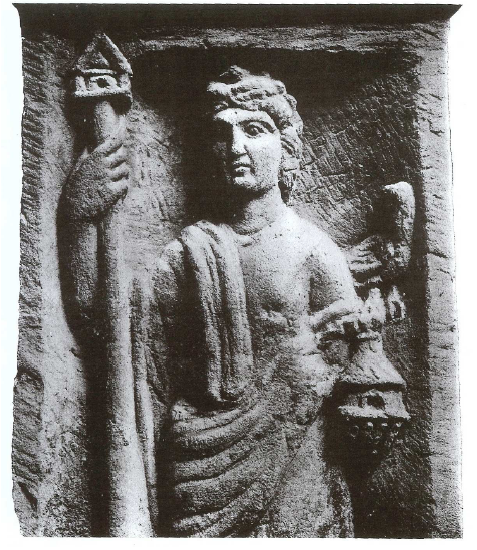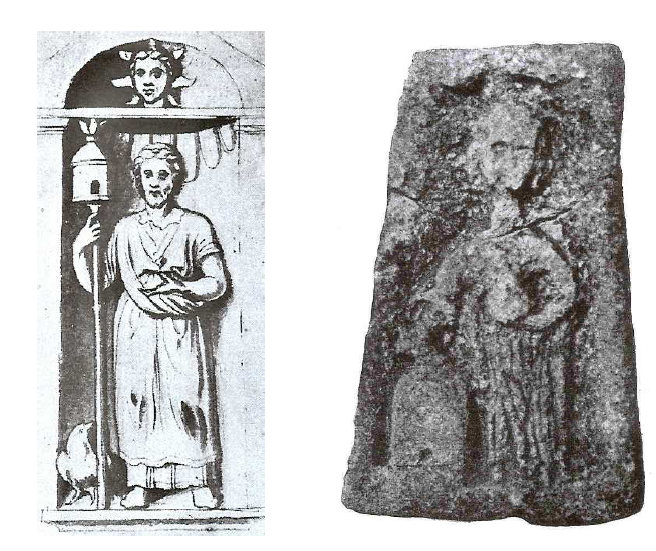1) Epigraphy and Iconography
The goddess name Nantosuelta is known from a single inscription, belonging to between 150 and 250 AD, discovered in Sarrebourg, near Metz (Moselle), in the territory of the Mediomatrici. The stone was unearthed in 1895, about 20 metres from a mithraeum*, excavated at the bottom of the Mount Marxberg, on the north side of the Rebberg.681 This shows that oriental and Celtic deities could be worshipped side by side on a same site. The dedication, which makes her the consort of the hammer-god Sucellus, is combined with a portrayal depicting the couple: Deo Sucello Nantosuelt(a)e Bellausus Mass(a)e filius v(otum) s(olvit) l(ibens) m(erito), ‘To the god Sucellus and Nantosuelta, Bellausus, son of Massa, paid his vow willingly and deservedly’ (fig. 6).682 The dedicator, Bellausus, and his mother, Massa, have Celtic names and bear the unique name, which means that they are peregrines.683 The goddess is depicted wearing a diadem and a long tunic, which are typical Classical garments denoting majesty and sovereignty. As for her attributes, they are not clearly identifiable and remain difficult to decipher. What is certain is that they are not of Classical character and that they are quite uncommon. In her left hand, Nantosuelta has a long pole surmounted by an object in the shape of a small house, while in her right hand she probably holds a patera* above an altar.684 Under the niche where the couple stand, the image of a huge crow appears.
The singularity of her attributes enables us to identify the goddess on anepigraphic* reliefs*, such as the other altar from Sarrebourg (Moselle), discovered on the same site. She is pictured on her own, with the staff-house emblem in her right hand and a cassolette for incense or a beehive surmounted by a crow in her left hand (fig. 6 and 7).685 Three superimposed objects of round-shape, interpreted as honeycombs, honey cakes or paterae*, appear at her feet on the left hand-side.686 The fact that she is portrayed on her own evidences her independence as a goddess and proves that she was worshipped individually. The inscription accompanying the image does not mention her name: In h(ono)r(em) d(omus) d(ivinae), M(arcus) Tignuarius v(otum) s(olvit) l(ibens) m(erito), ‘In honour of the Divine House, Marcus Tignuarius paid his vow willingly and deservedly’.687 The dedicator Marcus Tignuarius bears the duo nomina; a form particularly in use at the end of the 2nd c. AD.688 The abbreviated formula In h. d. d. indicates that the inscription dates from the end of the 2nd c. AD or the beginning of the 3rd c. AD.689


Nantosuelta is recognizable by her staff-house attribute on a lost relief* discovered in Spire, situated south-east of Mannheim (Germany), in the territory of the Nemetes (fig. 8).690The drawing is probably not very faithful to the original relief*. The goddess is accompanied by a crow standing at her feet. She holds a round object, possibly a cake, in her left hand. The peculiar aspect of this relief* is that the goddess is topped by a solar head, which may be indicative of a connection with the sun. Another possible representation of her was discovered in Tetig, located between Metz and Sarrebruck (Moselle).691 The relief* is crude and damaged and seems to be of indigenous character (fig. 8). The goddess holds a huge beehive or house in her right hand and a round object, perhaps a cup or a cake, in her left hand. The fact that the relief* is small (25x17 cm) and was discovered in a modest villa rustica* may attest to Nantosuelta’s protective aspect.692

Other portrayals of the hammer god and a female partner have been discovered in various other places, such as in Oberseebach (Bas-Rhin),693 Grünwinkel,694 Mainz (Germany),695 Jouey,696 Dijon,697 Nuits-Saint-Georges-Les Bolards (Côte d’Or),698 and Besançon (Doubs).699In addition to not being identified by an inscription, the goddess accompanying the hammer god does not possess the distinctive attributes of Nantosuelta. Consequently, contrary to what Green advocates, those reliefs* should not be regarded as depictions of Sucellus and Nantosuelta.700 Sucellus’s female consort is actually the archetype of the Mother Goddess. She is represented seated on a throne beside the god and bearing the classical attributes of the Terra Mater, such as the diadem, the tunic, the patera*, horns of plenty, baskets of fruit, apples, jars or pots, etc. Moreover, it is worth noting that Celtic gods and goddesses are usually polyandrous* figures. Therefore, it is not surprising to find a god associated with different female partners in the images – and vice versa. The Gaulish god of hot springs Borvo is for instance partnered with both Damona and Bormana.701 As for Damona, she has two other consorts: Albius and Moritasgus.702 Similarly, in Irish mythology, the Dagda is described as the husband of the Mórrígain703 and of the river-goddess Bóinn.704 It is thus important not to jump to conclusions as regards the portrayals of Sucellus and Nantosuelta.